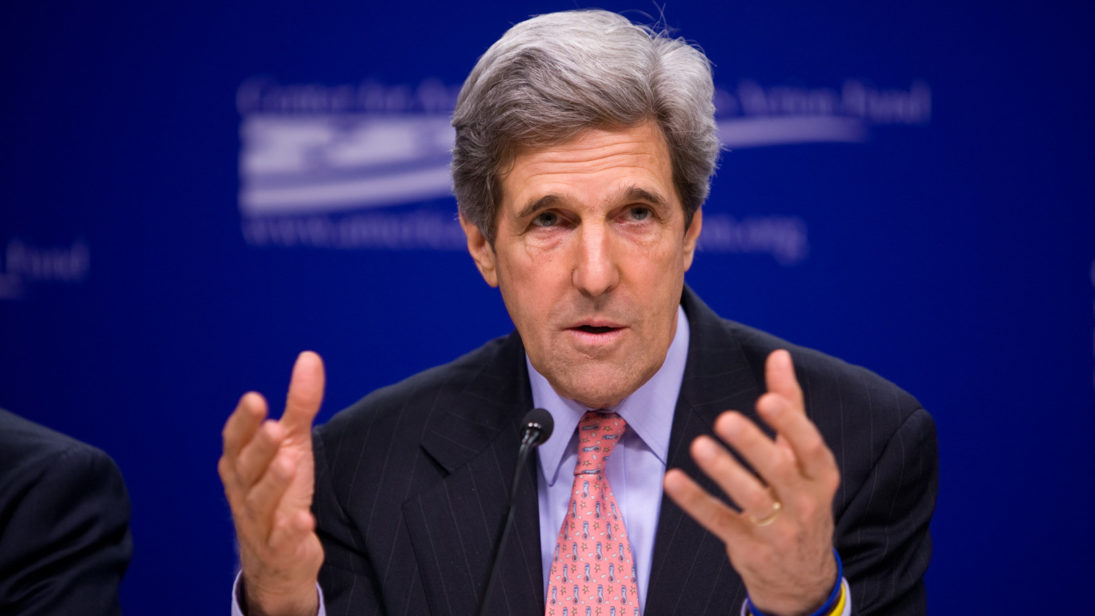
The second Strategic and Commercial Dialogue (S&CD) has furthered the momentum of strengthening ties between India and the United States in the wake of the signing of the Logistics Exchange Memorandum of Agreement (LEMOA) in Washington. The bilateral dialogue was expected to be largely symbolic given the proximity to U.S. elections and lingering diplomatic challenges in the form of India’s membership to the Nuclear Suppliers Group, terrorism emanating from Pakistan, and trade agreements. Unexpectedly, however, the dialogue proved substantive by highlighting some key convergences and even challenges in the United States-India relationship.
U.S. Secretary of State John Kerry’s call for Pakistan to take concrete steps to fight terrorism within its border reflects a clear break from the previous American position of neutrality regarding India and Pakistan. In addition, he echoed India’s concerns of Pakistan’s policy of distinguishing between “good” and “bad” terrorists, and supported India by urging Pakistan to bring the perpetrators of the 26/11 attacks in Mumbai and the attack on the Pathankot airbase to justice. The agreement to exchange terrorist screening information is one substantive example that exhibits this bilateral convergence in countering terrorism.
While Pakistan remains one of India’s main security challenges, there has been little, if any, engagement with the United States on India’s western front. Pakistan geographically falls under the U.S. Central Command. Indo-U.S. defense ties have been improving significantly, but the engagement has mostly focused on East and Southeast Asia. Almost all U.S. military engagements with India are under the Pacific Command, whose remit ends at the start of the Arabian Sea. Kerry’s remarks regarding terrorism emanating from Pakistan, while welcome, remain bereft of any meaningful cooperation on security threats from the west of India. While the primary American interest remains counterbalancing China, New Delhi expects further cooperation and support in tackling threats emanating from Pakistan, especially in respect to cross-border terrorism and nuclear security challenges.
However, the United States and India’s shared interest in a stable, democratic Afghanistan that would prevent the rise of the Taliban has evolved into substantive cooperation in several dimensions. The announcement during the S&CD regarding United States-India-Afghanistan trilateral talks starting up again, scheduled for the sidelines of the United Nations General Assembly session in September to fine-tune counter-terror measures, reflects India’s interests in the region. First, the United States has encouraged Indian economic projects in Afghanistan, such as the Afghan-India Friendship Dam, operationalized this past June. Secondly, India is also set to deliver more arms to Afghanistan to help it fight Islamist militants, including more Mi-25 attack helicopters and smaller helicopters used for transporting troops and medical emergencies, and spares for existing Russian-origin aircraft in the Afghan air force fleet amongst other equipment. Last month, the commander of the U.S. forces in Afghanistan, General John Nicholson, held talks to find ways in which New Delhi could help the Afghan air force, which is struggling to maintain aging Russian aircraft because of sanctions on Moscow.
The S&CD also agreed on the necessity for mechanisms to further elevate trade and investment between India and the United States. Both countries still lack a Free Trade Agreement (FTA), which hinders the free movement of goods and limits trade potential. The bilateral trade figure between the two countries was $109 billion in 2015, significantly shy of the publicly-stated goal of $500 billion. India and the United States also lack a bilateral investment treaty (BIT), which is considered essential for securing stable investment flows and boosting growth in services. The lack of significant growth in economic engagement is reflective of the need for both countries to engage on issues like FTAs and regional pacts, like the Trans-Pacific Partnership (TPP). India’s protectionist trade policies and the lack of political will on the American side are two factors that have contributed to the lack of progress in Indo-U.S. trade.
Slow progress on trade notwithstanding, the strategic dimensions of the relationship were strengthened with India and the United States signing the LEMOA, which will give the militaries of both countries access to each other’s facilities for supplies and repairs on mutual consent. While these exchanges are a regular feature between the militaries of both countries, the agreement institutionalizes the process. While the S&CD saw little talk on specifics of defense platforms, there are ongoing exchanges under the Defense Technology Trade Initiative (DTTI) regarding procurement of Lockheed Martin F-16’s, jet engine technologies, and aircraft carrier technologies among other things. Additionally, New Delhi has articulated that there exists a need for articulation of the term “major defense partner.”
Convergence in interests in the region, especially in view of China’s rise, has led to a significant upswing in defense cooperation between India and the United States. This strengthening of relations between India and the United States will continue later this year when the Obama administration takes up India’s bid to enter the Nuclear Suppliers Group as one of its final diplomatic pushes. However, cooperation on trade, and Pakistan, even though both countries have to a great extent compartmentalized their diverging engagements with Islamabad in their strategic embrace to counterbalance China, require further attention.
***
Image 1: Ralph Alswang, Flickr
Image 2: Prakash Singh-AFP, Getty



